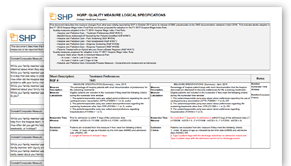2017 will be an important year for the Hospice Quality Reporting Program (HQRP). CMS plans to publicly share quality scores on a Hospice Compare website starting this year. On January 18th, CMS provided a full day of training to providers in Baltimore to share information on HQRP. Along with this on-site presentation, CMS live-streamed the event online to allow as many hospices as possible to participate.
The presentations included information on both the Hospice Item Set (HIS) and the Consumer Assessment of Healthcare Providers and Systems (CAHPS) Hospice Experience of Care Survey. Here are some of the highlights:
- A CMS Hospice Compare website, which will provide valuable information regarding the quality of care provided by Medicare-certified hospice agencies throughout the nation, is expected to be available in the late summer of 2017
- The seven currently available Hospice Item Set (HIS) based quality measures (QMs) as well as eight CAHPS Hospice based quality measures will be reported on the Hospice Compare website
- The two new HIS based measures (Hospice and Palliative Care Composite Measure and the Hospice Visits When Death is Imminent Measure pair) will not be incorporated at this time
- Like other CMS Compare websites, the Hospice Compare website will, in time, feature a quality rating system that gives each hospice a rating of between one and five stars
There were over 250 slides shared as part of the training. To make it easier to see the updates to HIS 2.0 as well as the changes to CAHPS domains, SHP created two crosswalks that demonstrate the adjustments that are being made.
In December 2016, CMS began to share the national benchmarks for the HIS and CAHPS Hospice quality measures on the data.medicare.gov website. As a result hospices can now compare themselves to their peers at the national level.
Access to a benchmark is an important way to validate and rank your performance against your peers. To identify best practices and to target weaker performances, you need the ability to drill down into your data by parameters such as team and case manager. This capability can help hospices better identify and target their Quality Assurance and Performance Improvement (QAPI) initiatives.
When looking at the CMS December 2016 HIS and CAHPS data compared to that of the SHP client database, you can clearly see the improvements can be achieved when you actively use benchmarking and performance improvement software with drilldown capabilities.
| Measure Name | CMS National Average | SHP National Average | Difference |
|---|---|---|---|
| The percentage of hospice patients who were offered a treatment option when at risk for Opioid-Induced Constipation | 94.1% | 96.1% | 2.0% |
| The percentage of hospice patients who were checked for pain when admitted to hospice | 94.0% | 97.3% | 3.3% |
| The percentage of hospice patients who received a timely, thorough pain assessment (cause, type, and impact) when the patient reported pain | 73.6% | 83.7% | 7.4% |
| The percentage of hospice patients who were checked to see whether shortness of breath was a problem when admitted to hospice | 97.7% | 98.7% | 1.0% |
| The percentage of hospice patients who received timely treatment when experiencing shortness of breath | 94.8% | 97.2% | 2.4% |
| The percentage of hospice patients who were asked about their preference for life-sustaining treatments (CPR, ventilator support, hospitalization, etc.) | 98.4% | 99.3% | 0.9% |
| The percentage of hospice patients who were invited to discuss spiritual or religious concerns, beliefs, values | 93.3% | 96.9% | 3.6% |
This data includes the national averages (mean) for quality measure scores of Medicare-certified hospice agencies calculated from the Hospice Item Set (HIS) for July 1, 2015 to June 30, 2016.
Hospices should be stepping up their QAPI initiatives for the HIS process measures and CAHPS survey results in order to be recognized as high performing providers as consumers begin to search this year for quality on the Hospice Compare website.


